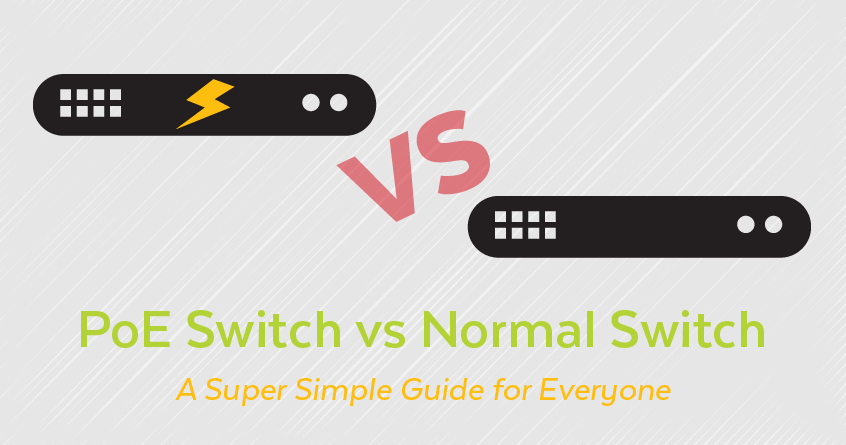Introduction
As technology advances, the number and variety of components for an efficient telecommunications network are changing as well. One component that will be critical to the smooth operation of any network is the network switch. There are two main types of switches to choose from – a regular network switch or a Power over Ethernet (PoE) switch.
To ensure you make an educated and informed decision that best serves your device demands, read on for (1) an explanation of PoE; and (2) considerations for deciding between a PoE switch and a regular network switch.
What is PoE?
Traditionally, when a device is connected to a network it requires two inputs: a power cord and a network cable. PoE is a technology that allows an Ethernet cable to carry electrical power.
In a PoE network, the power sourcing equipment can supply power and transmit data to network devices. All this is done by a single, PoE cable.
In order for devices to establish a network connection with a PoE cable, the network must include either (1) a PoE switch; or (2) a normal switch and an additional device such as a PoE injector or splitter.

What Devices Can Use PoE?
PoE provides value for devices and networks that require power but also involve transmission of data. The number of devices controlled remotely and requiring date are increasing exponentially as companies take advantage of the Internet of Things (IoT). The number of IoT devices was predicted to number 8.4 million in 2017.
This rapid expansion of network-connected devices will only increase the importance of PoE technology to most networking infrastructures.
While PoE has numerous applications, the three most common areas of implementation are currently:
- VoIP Phones: VoIP phones are the original PoE devices, with PoE allowing for a single connection to the wall socket and the ability for remote powering down
- IP Cameras: Security camera technology is constantly evolving, and one improvement is the use of PoE, enabling for fast deployment and simple repositioning.
- Wireless: Many wireless access points are PoE compatible, allowing for remote positioning. RFID readers are also often PoE compatible, which allows for easy relocation.
More recent technology that benefits from PoE is smart home automation. This includes LED lighting, heating and cooling systems, appliances, voice assistants, and electrical car charging stations.
PoE Switches v. Regular Switches
The primary differences between PoE switches and regular switches relate to PoE accessibility. A regular switch is not PoE enabled to supply power over Ethernet. A regular switch, however, can become PoE enabled by connecting a PoE injector or PoE splitter.
When deciding which switch will best serve your networking infrastructure, you should consider the benefits and limitations of PoE devices for your network.
Benefits of PoE Switches
As you decide which switch to choose, it is important to understand the benefits of PoE switches:
- Reduced Costs. PoE eliminates the need to run additional power cables to devices, saves costs on power cables, power outlets, and infrastructure equipment required for electrical installation. Ethernet cables cost less and are often already installed in buildings. If not already installed, remote installation costs less than fiber because no electrician is required.
- Adaptability. PoE powered devices can be easily moved to locations without power outlets. This allows for devices to be placed in hard to reach locations or other locations less proximal to a power source. One example of this is security cameras, as power outlets are rarely available above ceilings.
- Maximize Power Resources. A PoE switch can automatically detect power consumption by PoE powered devices and supply on the required amount of power. This ability to allocate power minimized power waste and helps businesses save money.
- Future Proof. The IoT space is booming. Incorporating PoE switches into your network infrastructure ensures it is able to support the increasing number of devices optimized to leverage this technology.
Limitations of PoE Switches
There are, however, some scenarios where a regular network switch may be a better choice:
- The furthest distance a PoE switch can transmit data is 100 meters. This is problematic for large networks spanning enterprises, campuses, hotels, or retail operations. A PoE ethernet extender, however, can increase the transmission distance to 4000 feet.
- If a device is not PoE compliant, it will require either an injector or splitter to connect to the PoE switch.
- If devices have significant power demands, they may exceed the PoE budget for power. The power capability of PoE, however, has increased significantly in the last several years. As of 2017, PoE is able to power devices as powerful as computers and televisions.
Which Should I Choose?
The good news is that PoE and non-PoE devices can mix in the same network, but the reality is that a non-PoE enabled device is not the right choice.
Unless you anticipate supporting a large number of legacy devices, your network spans an incredibly large distance, or you have devices that require significant power demands, a PoE switch is likely the way to go. Given the rapid expansion of IoT, all signs point to new devices being PoE enabled. Preparing your network to support these devices will position you to quickly take advantage of new technology.
Find the Right Switch For You
No matter how you decide to configure your network, Planet Technology has a variety of products to suit your needs. As you consider the options for network switches, be sure to understand how many ports you will need for your devices and the power demands. Once you have a general understanding of your power demands, you will also need to ensure there is sufficient power budget. The switch must provide enough power for each port.
Contact us today to find out how we can help provide the products needed to optimize your device connections. We are happy to assist with complex projects and to provide custom quotes as needed.



Join the Discussion One Comment